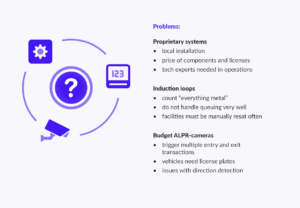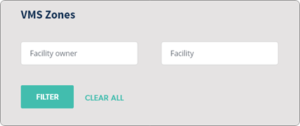First of all the counting part of parking has traditionally been delivered as proprietary systems by a few major players in the industry. A typical installation would be induction loops connected with cables to a local server running counting logic software, which again is connected with cables to a Variable Message Sign (VMS) showing the occupancy.
Secondly, most Automatic License Plate Recognition (ALPR) parking management systems are designed to create as many visits as possible, matching an entry transaction with an exit transaction, not to count. Even though there are no strong candidates today, video-trigging will no doubt be an important part of the input to counting systems in the years to come as machine learning algorithms keep getting better and more reliable object IDs are generated. Recent mergers and acquisitions (M&A) between ALPR-camera vendors and detection-SW vendors underline this point. Also upcoming products combining laser and ALPR in one unit will increase the counting quality in ALPR facilities. However, not all facilities need ALPR identification and ALPR-cameras will always have physical limitations. They are simply not suitable in all environments.
 Based on our own experience and feedback from our Clients saying “Counting is a problem for us”, Hi! has over the last years developed a dedicated counting module to deal with these issues.
Based on our own experience and feedback from our Clients saying “Counting is a problem for us”, Hi! has over the last years developed a dedicated counting module to deal with these issues.
The counting module is flexible on the input side, in the sense that we can use traditional detection method like induction loops and also handle various types of video inputs. However, most effort has been put on R&D together with laser specialist, BEA, to provide a near 100 percent detection method for counting. If there is a need for counting individuals instead of vehicles, the SIGMA all-in-one people counter from BEA (https://www.meetsigma.io) , can be used as another input to the system.
What kind of detection method we use depends on the existing infrastructure and the Clients quality requirements. Input data is usually sent to the Central System using a redundant mobile broadband solution.
Once the data arrives in the Central System, running on the latest Azure Kubernetes technology, an orchestration mechanism makes sure the data follow the correct paths and processes the data before it is transformed to useful information. This information is either exposed to an API (Like our Client Parkering Göteborg) or on the VMS adapter (like our Client Frydenbø) which is integrated with the VMS specialist Sernis, using a redundant mobile broadband solution.

Multi-input multi-output cloud-based counting module
From the facility owner perspective all the complexity is hidden. Facility owner admins can change the actual capacity of the facility, while the facility owner wardens are still able to perform the classic manual reset operation. This time not by accessing an IO Controller in a roadside rack or a dedicated work station in a booth, but simply by logging into the portal, pick a facility and make changes from a static or handheld device with the OS and browser they prefer.


User Interface

